Strategies for Mitigating Urban Residential Carbon Emissions: A System Dynamics Analysis of Kunming, China
Abstract
:1. Introduction
2. Methodology
2.1. Research Framework
2.2. Study Area
2.3. Carbon Emission Accounting Method
2.4. Influencing Factors
2.5. Model Building
2.6. Model Validation
3. Results
3.1. Simulation Results of the CO2 Emission Trend
3.2. Simulation of Single-Factor Carbon Emissions
3.3. Simulation of Multi-Factor Carbon Emissions
4. Discussion
5. Conclusions
Author Contributions
Funding
Data Availability Statement
Conflicts of Interest
Appendix A. Grey Relational Degree Analysis of Influencing Factors
| Subsystem | Influencing Factor | Grey Correlation Degree (γn) |
| Economic subsystem | GDP | 0.761 |
| Investment in fixed assets | 0.830 | |
| Per capita GDP | 0.819 | |
| Public budget expenditure | 0.844 | |
| Education expenditure | 0.821 | |
| Expenditure on science and technology | 0.824 | |
| Energy price | 0.722 | |
| Residential investment | 0.756 | |
| Social subsystem | Urbanization rate | 0.799 |
| Urban population | 0.881 | |
| Per capita disposable income of urban residents | 0.861 | |
| Per capita living area of urban residents | 0.752 | |
| Per capita consumption expenditure of urban residents | 0.736 | |
| Residential energy consumption expenditure of urban residents | 0.815 | |
| Residential consumption expenditure of urban residents | 0.868 | |
| Energy subsystem | Energy structure | 0.799 |
| Carbon emission intensity | 0.730 | |
| Per capita residential energy consumption | 0.730 | |
| Public education level (per 100,000 people enrolled in institutions of higher learning) | 0.843 | |
| Applied technology scientific and technological achievements | 0.767 | |
| Environmental subsystem | Heating degree day | 0.741 |
| Residential green space | 0.886 |
Appendix B. The Main Equations of the SD Systems
| Equation | The Adjusted R-Squared | DW | Correlation Coefficient | VIF |
|---|---|---|---|---|
| Social fixed-asset investment | 0.821 | |||
| Public budget expenditure | 0.925 | |||
| Social security and employment expenditure | 0.915 | 2.401 | 0.963 | 1 |
| Number of patent applications | 0.967 | 1.432 | 0.986 | 1 |
| Public education level | 0.869 | 2.249 | 0.942 | 1 |
| Residential land area | 0.921 | 1.609 | 0.966 | 1.377 |
| Per capita living area | 0.912 | 1.22 | 0.961 | 1.377 |
| Consumption Expenditure per urban resident | 0.966 | 1.1 | 0.861 | 1.487 |
| Residential consumption expenditure of urban residents | 0.915 | 2.223 | 0.966 | 1.137 |
| Residential energy consumption per capita | 0.818 | 1.313 | 0.844 | 1.084 |
| Technological Progress Impact Factor | 0.899 | 2.1 | 0.977 | 1 |
| Variable | Increase (10%) | Decrease (−10%) |
|---|---|---|
| Urbanization rate | 2.5 | 2.5 |
| Population growth rate | 5 | 0.16 |
| Energy prices | 3.8 | 3.8 |
| Proportion of scientific research expenditure | 2.8 | 2.8 |
| Proportion of educational expenditure | 3 | 3 |
| Greening area ratio | 1.3 | 1.3 |
| Residential investment ratio | 1.1 | 1.1 |
| GDP growth rate | 3.3 | 2.4 |
| Heating days | 8.3 | 8.3 |
| Natural gas consumption | 8.55 | 8.55 |
| Liquefied petroleum gas consumption | 1.8 | 1.8 |
| Coal consumption | 0.9 | 0.9 |
| Electricity consumption | 2.26 | 2.26 |
| Gas consumption | 0.44 | 0.44 |
Appendix C. Impacts of Different Factors on Carbon Emissions
| Urbanization Rate | Carbon Emission (×104 t CO₂) | |||
|---|---|---|---|---|
| Year | Basic program | Option 1 | Option 2 | Option 3 |
| 2022 | 303.12 | 295.35 | 311.00 | 319.00 |
| 2023 | 309.88 | 302.05 | 317.82 | 325.87 |
| 2024 | 320.42 | 312.49 | 328.47 | 336.62 |
| 2025 | 319.62 | 311.86 | 327.49 | 335.46 |
| 2026 | 340.54 | 332.57 | 348.62 | 356.81 |
| 2027 | 361.06 | 352.84 | 369.40 | 377.84 |
| 2028 | 374.69 | 366.32 | 383.17 | 391.76 |
| 2029 | 395.35 | 387.72 | 404.10 | 412.95 |
| 2030 | 410.82 | 401.99 | 419.76 | 428.80 |
| Education Input | Carbon Emission (×104 t CO₂) | |||
|---|---|---|---|---|
| Year | Basic program | Option 1 | Option 2 | Option 3 |
| 2022 | 303.12 | 304.12 | 302.13 | 301.13 |
| 2023 | 309.88 | 310.98 | 308.78 | 307.67 |
| 2024 | 320.42 | 321.67 | 319.18 | 317.94 |
| 2025 | 319.62 | 320.98 | 318.26 | 316.91 |
| 2026 | 340.54 | 342.12 | 338.97 | 337.40 |
| 2027 | 361.06 | 362.88 | 359.24 | 357.43 |
| 2028 | 374.69 | 376.76 | 372.63 | 370.56 |
| 2029 | 395.35 | 397.74 | 392.97 | 390.58 |
| 2030 | 410.82 | 413.54 | 408.10 | 405.38 |
| Energy Prices | Carbon Emission (×104 t CO₂) | |||
|---|---|---|---|---|
| Year | Basic program | Option 1 | Option 2 | Option 3 |
| 2022 | 303.12 | 304.30 | 301.94 | 300.76 |
| 2023 | 309.88 | 311.08 | 308.69 | 307.49 |
| 2024 | 320.42 | 321.62 | 319.22 | 318.02 |
| 2025 | 319.62 | 320.82 | 318.42 | 317.21 |
| 2026 | 340.54 | 341.74 | 339.34 | 338.14 |
| 2027 | 361.06 | 362.27 | 359.85 | 358.64 |
| 2028 | 374.69 | 375.91 | 373.47 | 372.25 |
| 2029 | 395.35 | 396.59 | 394.12 | 392.88 |
| 2030 | 410.82 | 412.08 | 409.56 | 408.31 |
| GDP Growth Rate | Carbon Emission (×104 t CO₂) | |||
|---|---|---|---|---|
| Year | Basic program | Option 1 | Option 2 | Option 3 |
| 2022 | 303.12 | 302.14 | 304.10 | 305.08 |
| 2023 | 309.88 | 307.80 | 311.97 | 314.08 |
| 2024 | 320.42 | 317.11 | 323.78 | 327.20 |
| 2025 | 319.62 | 315.10 | 324.25 | 328.99 |
| 2026 | 340.54 | 334.57 | 346.71 | 353.07 |
| 2027 | 361.06 | 353.38 | 369.06 | 377.38 |
| 2028 | 374.69 | 365.14 | 384.72 | 395.23 |
| 2029 | 395.35 | 383.60 | 407.78 | 420.92 |
| 2030 | 410.82 | 396.56 | 426.02 | 442.20 |
| Residential Investment Ratio | Carbon Emission (×104 t CO₂) | |||
|---|---|---|---|---|
| Year | Basic program | Option 1 | Option 2 | Option 3 |
| 2022 | 303.12 | 302.81 | 303.43 | 303.75 |
| 2023 | 309.88 | 309.57 | 310.19 | 310.51 |
| 2024 | 320.42 | 320.11 | 320.74 | 321.05 |
| 2025 | 319.62 | 319.32 | 319.92 | 320.22 |
| 2026 | 340.54 | 340.25 | 340.84 | 341.14 |
| 2027 | 361.06 | 360.76 | 361.36 | 361.66 |
| 2028 | 374.69 | 374.40 | 374.99 | 375.29 |
| 2029 | 395.35 | 395.06 | 395.65 | 395.95 |
| 2030 | 410.82 | 410.52 | 411.12 | 411.43 |
| Energy Structures | Carbon Emission (×104 t CO₂) | |||
|---|---|---|---|---|
| Year | Basic program | Option 1 | Option 2 | Option 3 |
| 2022 | 303.12 | 301.72 | 300.50 | 298.05 |
| 2023 | 309.88 | 308.45 | 307.20 | 304.69 |
| 2024 | 320.42 | 318.93 | 317.61 | 314.99 |
| 2025 | 319.62 | 318.10 | 316.78 | 314.12 |
| 2026 | 340.54 | 338.90 | 337.46 | 334.57 |
| 2027 | 361.06 | 359.31 | 357.77 | 354.69 |
| 2028 | 374.69 | 372.85 | 371.24 | 368.01 |
| 2029 | 395.35 | 393.41 | 391.70 | 388.28 |
| 2030 | 410.82 | 408.79 | 407.01 | 403.45 |
| Scientific Research Input | Carbon Emission (×104 t CO₂) | |||
|---|---|---|---|---|
| Year | Basic program | Option 1 | Option 2 | Option 3 |
| 2022 | 303.12 | 304.05 | 302.20 | 301.27 |
| 2023 | 309.88 | 310.90 | 308.86 | 307.84 |
| 2024 | 320.42 | 321.56 | 319.28 | 318.14 |
| 2025 | 319.62 | 320.85 | 318.39 | 317.16 |
| 2026 | 340.54 | 341.96 | 339.13 | 337.71 |
| 2027 | 361.06 | 362.69 | 359.44 | 357.82 |
| 2028 | 374.69 | 376.51 | 372.87 | 371.06 |
| 2029 | 395.35 | 397.43 | 393.28 | 391.20 |
| 2030 | 410.82 | 413.15 | 408.49 | 406.15 |
| Heating Days | Carbon Emission (×104 t CO₂) | |||
|---|---|---|---|---|
| Year | Basic program | Option 1 | Option 2 | Option 3 |
| 2022 | 303.12 | 305.90 | 300.34 | 297.57 |
| 2023 | 309.88 | 312.70 | 307.07 | 304.25 |
| 2024 | 320.42 | 323.25 | 317.60 | 314.52 |
| 2025 | 319.62 | 322.45 | 316.79 | 313.69 |
| 2026 | 340.54 | 343.37 | 337.72 | 334.89 |
| 2027 | 361.06 | 363.91 | 358.21 | 355.36 |
| 2028 | 374.69 | 377.57 | 371.82 | 368.94 |
| 2029 | 395.35 | 398.27 | 392.44 | 389.52 |
| 2030 | 410.82 | 413.78 | 407.86 | 404.63 |
| Greening Area Ratio | Carbon Emission (×104 t CO₂) | |||
|---|---|---|---|---|
| Year | Basic program | Option 1 | Option 2 | Option 3 |
| 2022 | 303.12 | 303.52 | 302.72 | 302.32 |
| 2023 | 309.88 | 310.29 | 309.48 | 309.07 |
| 2024 | 320.42 | 320.83 | 320.01 | 319.60 |
| 2025 | 319.62 | 320.04 | 319.20 | 318.79 |
| 2026 | 340.54 | 340.97 | 340.12 | 339.70 |
| 2027 | 361.06 | 361.49 | 360.64 | 360.21 |
| 2028 | 374.69 | 375.13 | 374.26 | 373.83 |
| 2029 | 395.35 | 395.79 | 394.92 | 394.48 |
| 2030 | 410.82 | 411.27 | 410.38 | 409.93 |
References
- IPCC. Climate Change 2023: Synthesis Report. Contribution of Working Groups I. II and III to the Sixth Assessment Report of the Intergovernmental Panel on Climate Change; IPCC: Geneva, Switzerland, 2023; pp. 35–115. [Google Scholar] [CrossRef]
- Rong, P.; Zhang, Y.; Qin, Y.; Liu, G.; Liu, R. Spatial differentiation of carbon emissions from residential energy consumption: A case study in Kaifeng, China. J. Environ. Manag. 2020, 271, 110895. [Google Scholar] [CrossRef]
- Chau, C.K.L.; Leung, T.M.; Ng, W.Y. A review on life cycle assessment, life cycle energy assessment and life cycle carbon emissions assessment on buildings. Appl. Energy 2015, 143, 395–413. [Google Scholar] [CrossRef]
- Geng, J.J.; Wang, J.J.; Huang, J.G.; Zhou, D.; Bai, J.; Wang, J.Y.; Zhang, H.; Duan, H.B.; Zhang, W.B. Quantification of the carbon emission of urban residential buildings: The case of the Greater Bay Area cities in China. Environ. Impact Assess. Rev. 2022, 95, 106775. [Google Scholar] [CrossRef]
- You, F.H.; Hu, D.; Zhang, H.; Guo, Z.; Zhao, Y.; Wang, B.; Yuan, Y. Carbon emissions in the life cycle of urban building system in China—A case study of residential buildings. Ecol. Complex. 2011, 8, 201–212. [Google Scholar] [CrossRef]
- Burleyson, C.D.; Iyer, G.; Hejazi, M.; Kim, S.; Kyle, P.; Rice, J.S.; Smith, A.D.; Taylor, Z.T.; Voisin, N.; Xie, Y.L. Future western US building electricity consumption in response to climate and population drivers: A comparative study of the impact of model structure. Energy 2020, 208, 118312. [Google Scholar] [CrossRef]
- Wang, Q.; Lin, J.; Zhou, K.; Fan, J.; Kwan, M.P. Does urbanization lead to less residential energy consumption? A comparative study of 136 countries. Energy 2020, 202, 117765. [Google Scholar] [CrossRef]
- Huo, T.F.; Li, X.H.; Cai, W.G.; Zuo, J.; Jia, F.Y.; Wei, H.F. Exploring the impact of urbanization on urban building carbon emissions in China: Evidence from a provincial panel data model. Sustain. Cities Soc. 2020, 56, 102068. [Google Scholar] [CrossRef]
- Gan, L.; Liu, Y.; Shi, Q.; Cai, W.; Ren, H. Regional inequality in the carbon emission intensity of public buildings in China. Build. Environ. 2022, 225, 109657. [Google Scholar] [CrossRef]
- Wu, L.F.; Huang, G.M.; Fan, J.L.; Zhang, F.C.; Wang, X.K.; Zeng, W.Z. Potential of kernel-based nonlinear extension of Arps decline model and gradient boosting with categorical features support for predicting daily global solar radiation in humid regions. Energy Convers. Manag. 2019, 183, 280–295. [Google Scholar] [CrossRef]
- Trotta, G. Factors affecting energy-saving behaviours and energy efficiency investments in British households. Energy Policy 2018, 114, 529–539. [Google Scholar] [CrossRef]
- Wan, C.; Shen, G.Q.; Choi, S. The moderating effect of subjective norm in predicting intention to use urban green spaces: A study of Hong Kong. Sustain. Cities Soc. 2018, 37, 288–297. [Google Scholar] [CrossRef]
- Shi, H.X.; Wang, S.Y.; Zhao, D.T. Exploring urban resident’s vehicular PM2.5 reduction behavior intention: An application of the extended theory of planned behavior. J. Clean. Prod. 2017, 147, 603–613. [Google Scholar] [CrossRef]
- Liu, X.; Wang, Q.C.; Wei, H.H.; Chi, H.L.; Ma, Y.T.; Jian, I.Y. Psychological and Demographic Factors Affecting Household Energy-Saving Intentions: A TPB-Based Study in Northwest China. Sustainability 2020, 12, 836. [Google Scholar] [CrossRef]
- Fan, J.B.; Ran, A.B.; Li, X.M. A Study on the Factors Affecting China’s Direct Household Carbon Emission and Comparison of Regional Differences. Sustainability 2019, 11, 4919. [Google Scholar] [CrossRef]
- Li, J.B.; Huang, X.J.; Yang, H.; Chuai, X.W.; Li, Y.; Qu, J.S.; Zhang, Z.Q. Situation and determinants of household carbon emissions in Northwest China. Habitat Int. 2016, 51, 178–187. [Google Scholar] [CrossRef]
- Fremstad, A.; Underwood, A.; Zahran, S. The Environmental Impact of Sharing: Household and Urban Economies in CO2 Emissions. Ecol. Econ. 2018, 145, 137–147. [Google Scholar] [CrossRef]
- Paone, A.; Bacher, J.P. The Impact of Building Occupant Behavior on Energy Efficiency and Methods to Influence It: A Review of the State of the Art. Energies 2018, 11, 953. [Google Scholar] [CrossRef]
- Hu, Z.; He, J.; Wang, Y. Factor analysis and enlightenment of household carbon emissions in Japan based on IPAT-LMDI extension model. Resour. Sci. 2018, 40, 1831–1842. [Google Scholar]
- Li, Z.; Liu, Y.Z.; Zhang, Z. Carbon Emission Characteristics and Reduction Pathways of Urban Household in China. Front. Environ. Sci. 2022, 10, 896765. [Google Scholar] [CrossRef]
- Jin, J.; Wang, Y.C.; Zheng, X.Y. District heating versus self-heating: Estimation of energy efficiency gap using regression discontinuity design. China Econ. Q. Int. 2021, 1, 208–220. [Google Scholar] [CrossRef]
- Payne, S.; Barker, A. Carbon regulation and pathways for institutional transition in market-led housing systems: A case study of English housebuilders and zero carbon housing policy. Environ. Plan. E-Nat. Space 2018, 1, 470–493. [Google Scholar] [CrossRef]
- Zhang, X.F.; Fan, D.C. The Spatial-Temporal Evolution of China’s Carbon Emission Intensity and the Analysis of Regional Emission Reduction Potential under the Carbon Emissions Trading Mechanism. Sustainability 2022, 14, 7442. [Google Scholar] [CrossRef]
- Li, H.; Cao, L.; Chen, Y.B.; Qiu, H.Y.; Huang, X.; Guo, W.Q.; Wang, S.T.; Sheng, W.G.; Zhou, Y.L.; Xu, Q. Emergy analysis-based study of the sustainable development of Kunming’s urban eco-economic system. Int. J. Urban Sci. 2023, 27, 322–343. [Google Scholar] [CrossRef]
- Shao, P.; Xin, J.Y.; Zhang, X.L.; Gong, C.S.; Ma, Y.J.; Wang, Y.S.; Wang, S.G.; Hu, B.; Ren, X.B.; Wang, B.Y. Aerosol optical properties and their impacts on the co-occurrence of surface ozone and particulate matter in Kunming City, on the Yunnan-Guizhou Plateau of China. Atmos. Res. 2022, 266, 105963. [Google Scholar] [CrossRef]
- Gao, Y.; Pitts, A.; Amsterdam Univ, P. The Ancient Southern Silk Road and the Contemporary One Belt and One Road in Southwest China Case study of Kunming City in Yunnan Province. In Proceedings of the 12th International Convention of Asia Scholars (ICAS), Electr Network, 24–28 August 2021; pp. 177–182. [Google Scholar]
- Liu, Z.; Sun, T.; Yu, Y.; Ke, P.; Deng, Z.; Lu, C.; Huo, D.; Ding, X. Near-Real-Time Carbon Emission Accounting Technology Toward Carbon Neutrality. Engineering 2022, 14, 44–51. [Google Scholar] [CrossRef]
- Wen, Z.; Yang, Z.; Xing, Q. A comprehensive evaluation of regional carbon emission based on the composite model in China: A case study of Huaibei city (China). Sci. Rep. 2023, 13, 15387. [Google Scholar] [CrossRef] [PubMed]
- Xiong, P.; Wu, X.; Ye, J. Building a novel multivariate nonlinear MGM(1,m,N|γ) model to forecast carbon emissions. Environ. Dev. Sustain. 2023, 25, 9647–9671. [Google Scholar] [CrossRef]
- Oh, J.; Hong, T.; Kim, H.; An, J.; Jeong, K.; Koo, C. Advanced Strategies for Net-Zero Energy Building: Focused on the Early Phase and Usage Phase of a Building’s Life Cycle. Sustainability 2017, 9, 2272. [Google Scholar] [CrossRef]
- Schmidt, M.; Crawford, R.H. A framework for the integrated optimisation of the life cycle greenhouse gas emissions and cost of buildings. Energy Build. 2018, 171, 155–167. [Google Scholar] [CrossRef]
- Zhong, X.; Li, X.; Li, Y. Urban Expansion and Carbon Emission Logistic Curve Hypothesis and Its Verification: A Case Study of Jiangsu Province. Land 2022, 11, 1066. [Google Scholar] [CrossRef]
- Cheng, S.; Zhou, X.; Zhou, H. Study on Carbon Emission Measurement in Building Materialization Stage. Sustainability 2023, 15, 5717. [Google Scholar] [CrossRef]
- People’s Government of Kunming. Kunming Statistical Yearbook. Available online: https://www.km.gov.cn/zfxxgk/fdzdgknr/tjxx/jjyxqk/tjnj/ (accessed on 18 January 2024).
- National Bureau of Statistics of China. Kunming Statistical Yearbook (2014–2021). Available online: https://www.stats.gov.cn/sj/ndsj/2022/indexeh.htm (accessed on 20 January 2024).
- National Development and Reform Commission of China. Technology Policy for Upgrading Coal Power Units for Energy Conservation and Emission Reduction. Available online: https://www.cmenhu.cn/13448.html (accessed on 20 January 2024).
- Zhou, G.H.; Chung, W.; Zhang, Y.X. Carbon dioxide emissions and energy efficiency analysis of China’s regional thermal electricity generation. J. Clean. Prod. 2014, 83, 173–184. [Google Scholar] [CrossRef]
- Huang, Y.S.; Shen, L.; Liu, H. Grey relational analysis, principal component analysis and forecasting of carbon emissions based on long short-term memory in China. J. Clean. Prod. 2019, 209, 415–423. [Google Scholar] [CrossRef]
- Kim, G.; Jong, Y.; Liu, S.F. Generalized Hybrid Grey Relation Method for Multiple Attribute Mixed Type Decision Making. J. Grey Syst. 2014, 26, 142–153. [Google Scholar]
- Sun, Y.M.; Liu, S.X.; Li, L. Grey Correlation Analysis of Transportation Carbon Emissions under the Background of Carbon Peak and Carbon Neutrality. Energies 2022, 15, 3064. [Google Scholar] [CrossRef]
- Lv, T.G.; Hu, H.; Zhang, X.M.; Sun, L.; Li, Z.L.; Chen, Y.J.; Fu, S.F. Driving mechanism of the allometric relationship between economic development and carbon emissions in the Yangtze River Delta urban agglomeration, China. Environ. Dev. Sustain. 2023. [Google Scholar] [CrossRef]
- Forrester, J.W. System dynamics—The next fifty years. Syst. Dyn. Rev. 2007, 23, 359–370. [Google Scholar] [CrossRef]
- Zhan, J.Y.; Wang, C.; Wang, H.H.; Zhang, F.; Li, Z.H. Pathways to achieve carbon emission peak and carbon neutrality by 2060: A case study in the Beijing-Tianjin-Hebei region, China. Renew. Sustain. Energy Rev. 2024, 189, 113955. [Google Scholar] [CrossRef]
- Huo, T.F.; Ma, Y.L.; Xu, L.B.; Feng, W.; Cai, W.G. Carbon emissions in China’s urban residential building sector through 2060: A dynamic scenario simulation. Energy 2022, 254, 124395. [Google Scholar] [CrossRef]
- Huo, T.F.; Xu, L.B.; Feng, W.; Cai, W.G.; Liu, B.S. Dynamic scenario simulations of carbon emission peak in China’s city-scale urban residential building sector through 2050. Energy Policy 2021, 159, 112612. [Google Scholar] [CrossRef]
- Murray, P.; Marquant, J.; Niffeler, M.; Mavromatidis, G.; Orehounig, K. Optimal transformation strategies for buildings, neighbourhoods and districts to reach CO2 emission reduction targets. Energy Build. 2020, 207, 109569. [Google Scholar] [CrossRef]
- Liu, L.Y.; Tang, Y.L.; Chen, Y.Y.; Zhou, X.; Bedra, K.B. Urban Sprawl and Carbon Emissions Effects in City Areas Based on System Dynamics: A Case Study of Changsha City. Appl. Sci. 2022, 12, 3244. [Google Scholar] [CrossRef]
- Kunming People’s Government. The 14th Five-Year Plan for the National economic and Social Development of Kunming City and the Outline of the Long-Term Goals for 2035. Available online: https://www.km.gov.cn/c/2021-04-06/3890927.shtml (accessed on 20 January 2024).
- Chicco, D.; Warrens, M.J.; Jurman, G. The coefficient of determination R-squared is more informative than SMAPE, MAE, MAPE, MSE and RMSE in regression analysis evaluation. Peerj Comput. Sci. 2021, 7, e623. [Google Scholar] [CrossRef] [PubMed]
- Uyanto, S.S. Power comparisons of five most commonly used autocorrelation tests. Pak. J. Stat. Oper. Res. 2020, 16, 119–130. [Google Scholar] [CrossRef]
- Shrestha, N. Detecting Multicollinearity in Regression Analysis. Am. J. Appl. Math. Stat. 2020, 8, 39–42. [Google Scholar] [CrossRef]
- Liu, J.K.; Liu, Y.D.; Wang, X.T. An environmental assessment model of construction and demolition waste based on system dynamics: A case study in Guangzhou. Environ. Sci. Pollut. Res. 2020, 27, 37237–37259. [Google Scholar] [CrossRef] [PubMed]
- Ning, X.; He, Y.; Zhang, J.; Wu, C.; Zhang, Y. Analysis of Carbon Emission Projections and Reduction Potential of Resource-Dependent Urban Agglomerations from the Perspective of Multiple Scenarios-A Case Study of Hu-Bao-O-Yu Urban Agglomeration. Int. J. Environ. Res. Public Health 2023, 20, 4250. [Google Scholar] [CrossRef] [PubMed]
- Tian, X.; Geng, Y.; Dong, H.; Dong, L.; Fujita, T.; Wang, Y.; Zhao, H.; Wu, R.; Liu, Z.; Sun, L. Regional household carbon footprint in China: A case of Liaoning province. J. Clean. Prod. 2016, 114, 401–411. [Google Scholar] [CrossRef]
- Oda, T.; Feng, L.; Palmer, P.; Baker, D.F.; Ott, L.E. Assumptions about prior fossil fuel inventories impact our ability to estimate posterior net CO2 fluxes that are needed for verifying national inventories. Environ. Res. Lett. 2023, 18, 124030. [Google Scholar] [CrossRef]
- Schernikau, L.; Smith, W.H. Climate impacts of fossil fuels in today’s electricity systems. J. S. Afr. Inst. Min. Metall. 2022, 122, 133–145. [Google Scholar] [CrossRef]
- Zheng, X.Q.; Wang, J.Y.; Chen, Y.; Tian, C.; Li, X.M. Potential pathways to reach energy-related CO2 emission peak in China: Analysis of different scenarios. Environ. Sci. Pollut. Res. 2023, 30, 66328–66345. [Google Scholar] [CrossRef] [PubMed]
- Sun, X.M.; Zhang, H.T.; Wang, X.Y.; Qiao, Z.K.; Li, J.S. Towards Sustainable Development: A Study of Cross-Regional Collaborative Carbon Emission Reduction in China. Sustainability 2022, 14, 9624. [Google Scholar] [CrossRef]
- Ge, X.X.; Qi, W. Analysis of CO2 Emission Drives Based on Energy Consumption and Prediction of Low Carbon Scenarios: A Case Study of Hebei Province. Pol. J. Environ. Stud. 2020, 29, 2185–2197. [Google Scholar] [CrossRef]
- Ayuketah, Y.; Gyamfi, S.; Diawuo, F.A.; Dagoumas, A.S. Assessment of low-carbon energy transitions policies for the energy demand sector of Cameroon. Energy Sustain. Dev. 2023, 72, 252–264. [Google Scholar] [CrossRef]
- Wang, J.Y.; He, D.Q. Sustainable urban development in China: Challenges and achievements. Mitig. Adapt. Strateg. Glob. Chang. 2015, 20, 665–682. [Google Scholar] [CrossRef]
- Wu, H.L.; Wang, L.; Peng, D.X.; Liu, B.J. Input-output efficiency model of urban green-energy development from the perspective of a low-carbon economy. Clean Energy 2022, 6, 905–916. [Google Scholar] [CrossRef]
- Liu, Y.; Cui, J.F.; Jiang, H.; Yan, H. Do county financial marketization reforms promote food total factor productivity growth?: A mechanistic analysis of the factors quality of land, labor, and capital. Front. Sustain. Food Syst. 2023, 7, 1263328. [Google Scholar] [CrossRef]

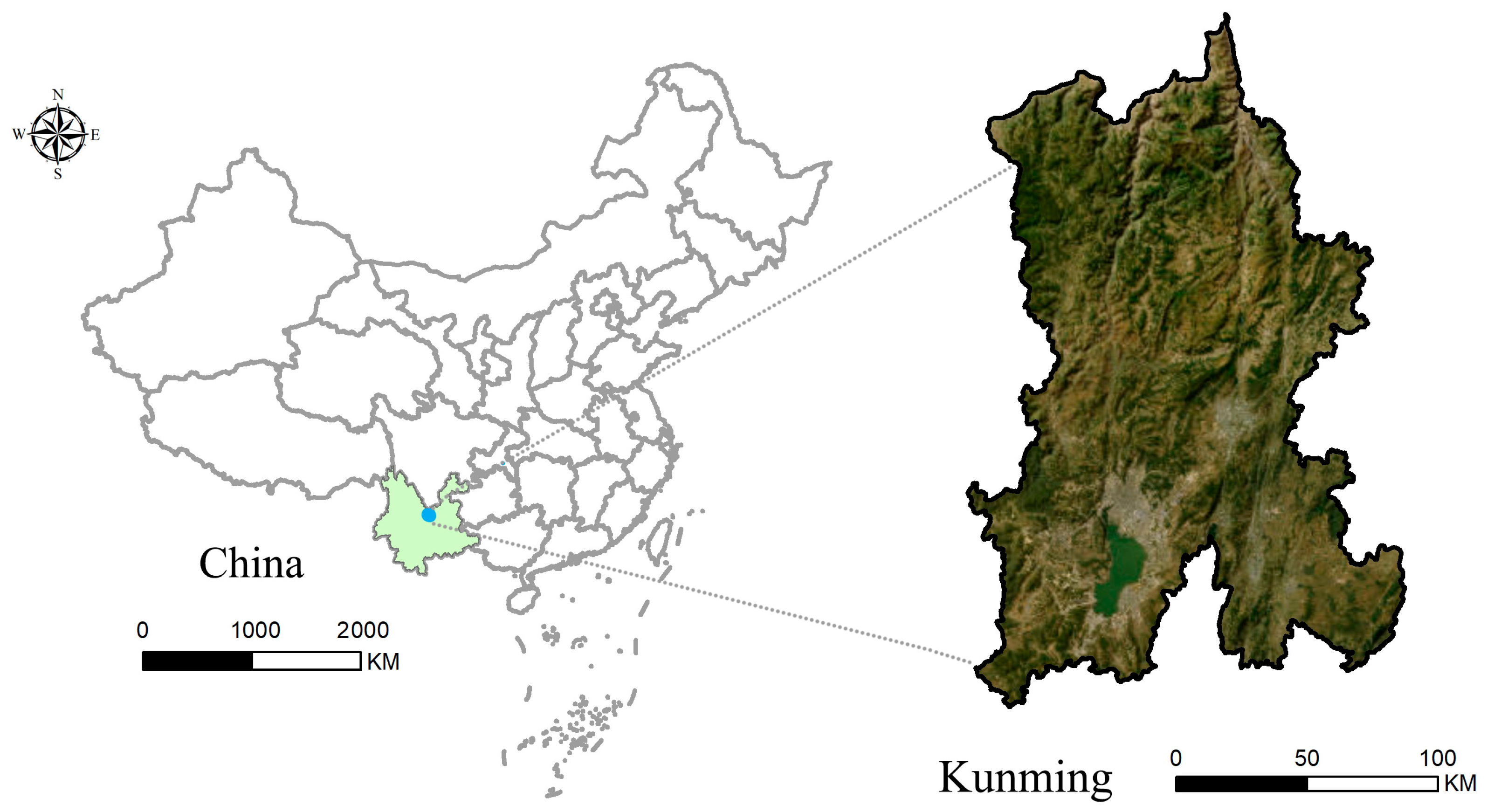
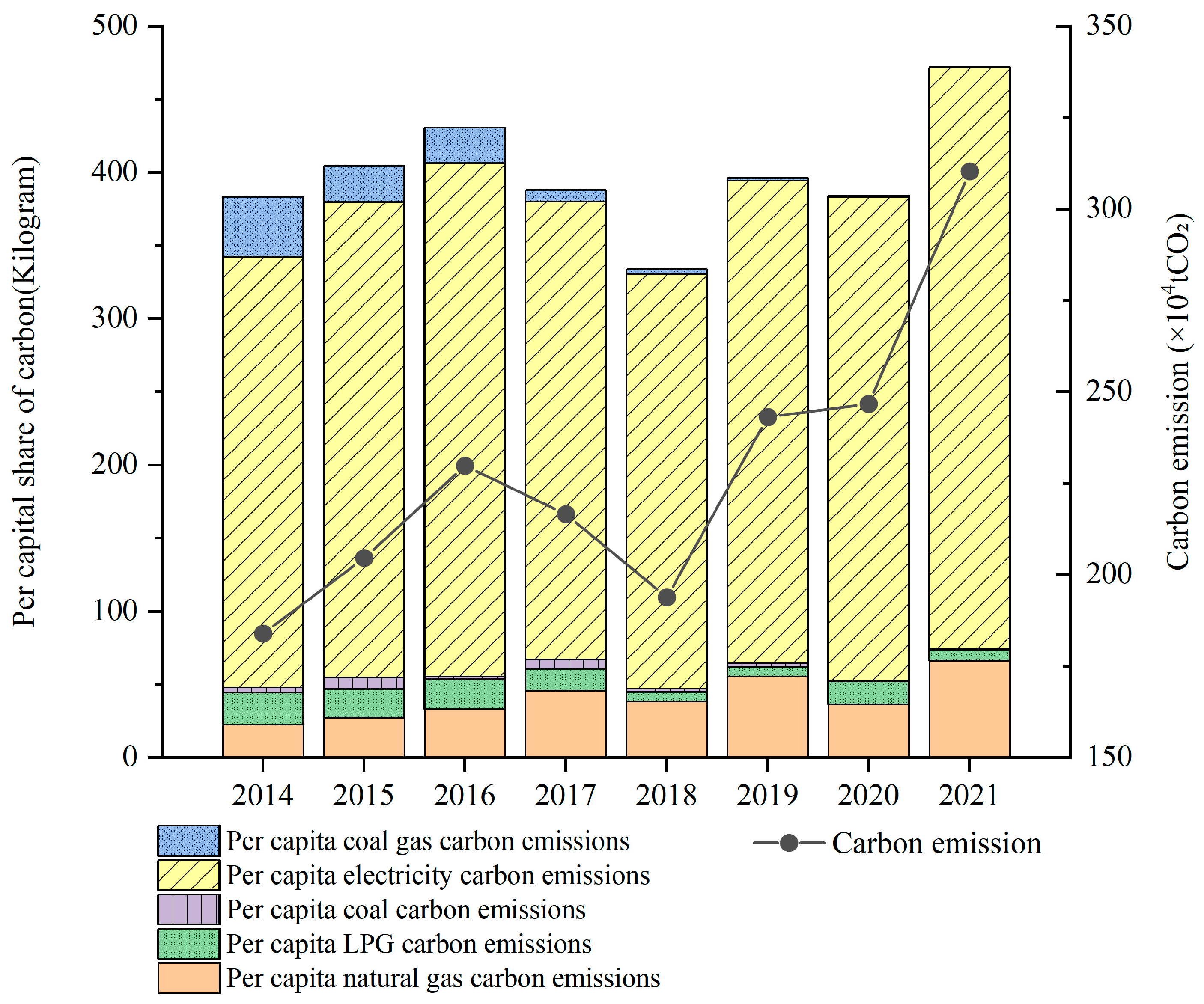
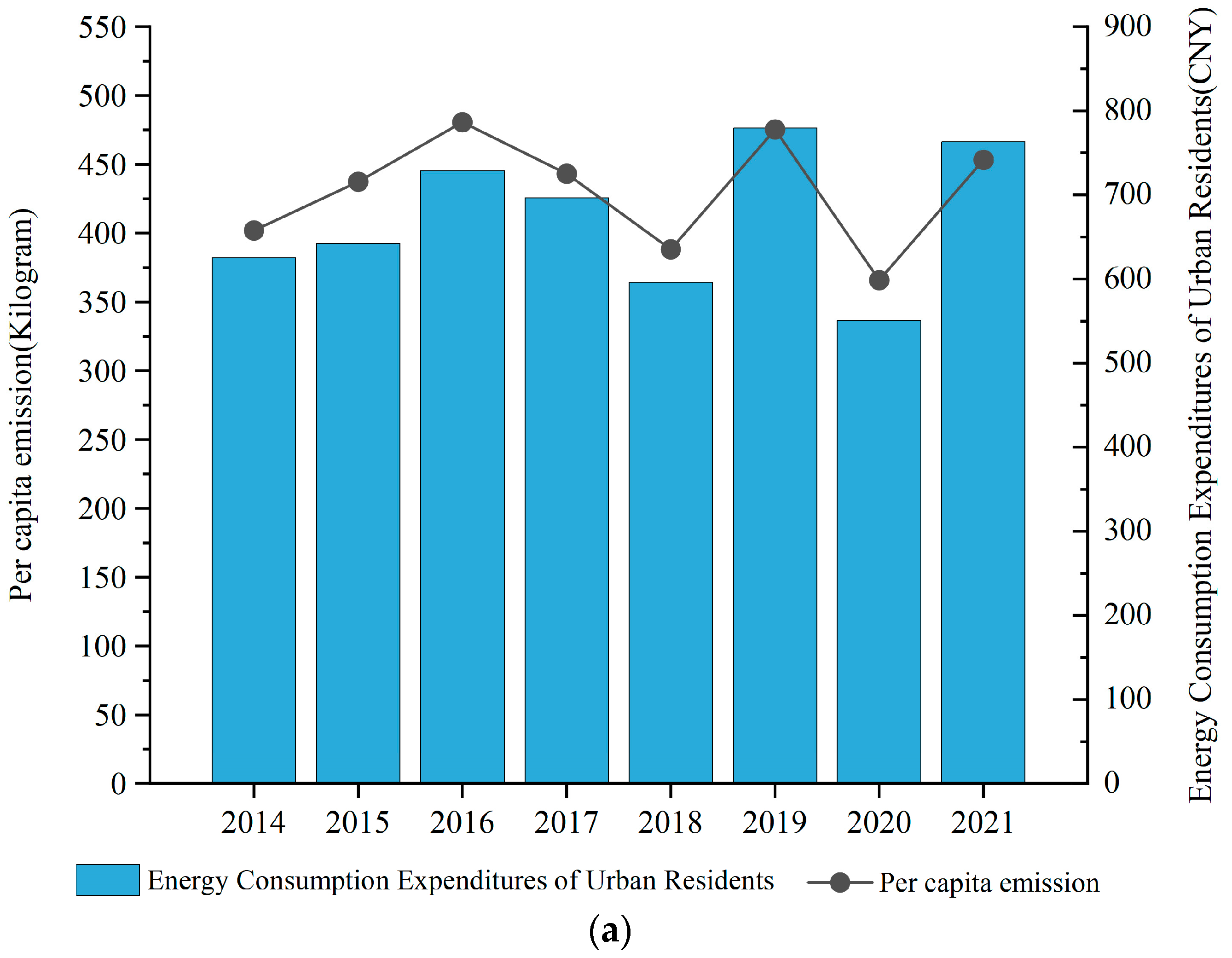



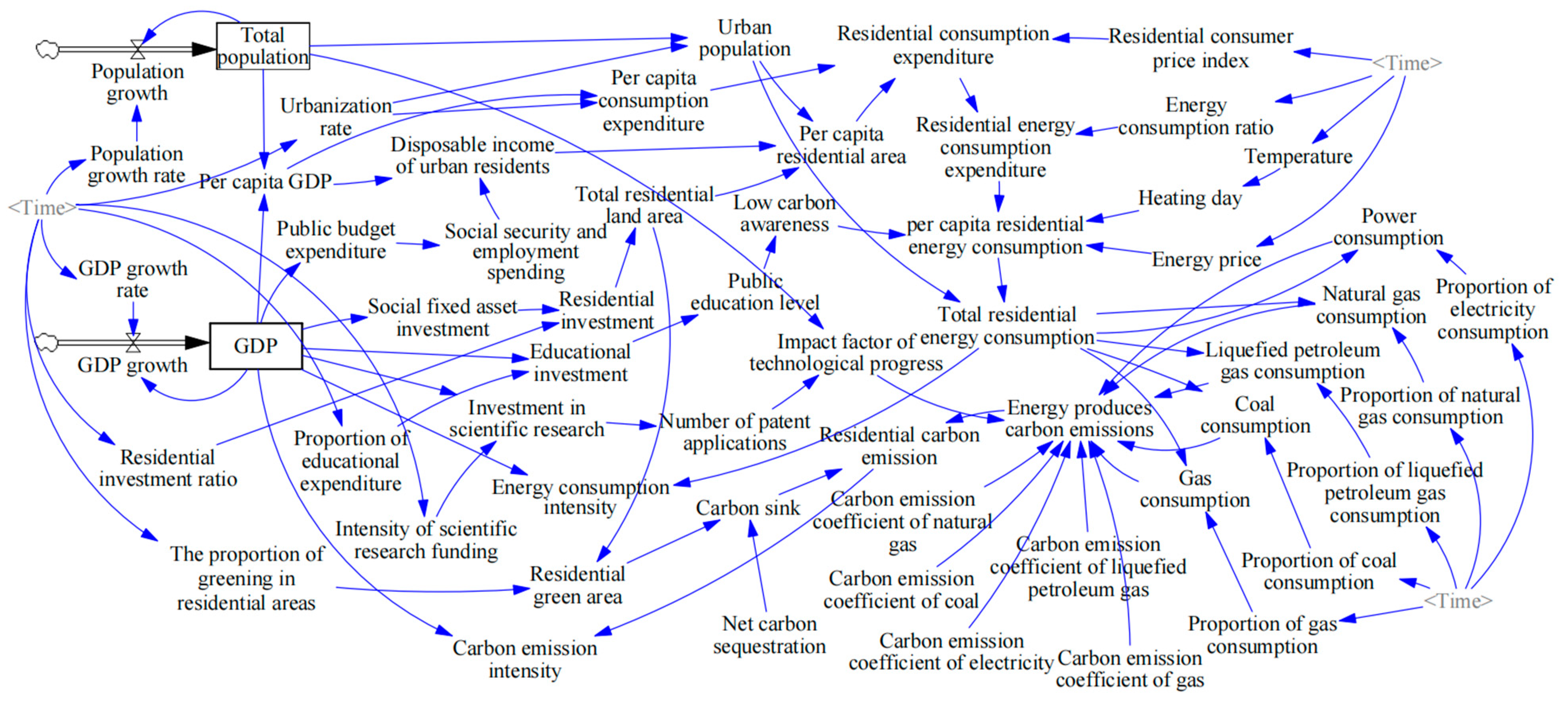
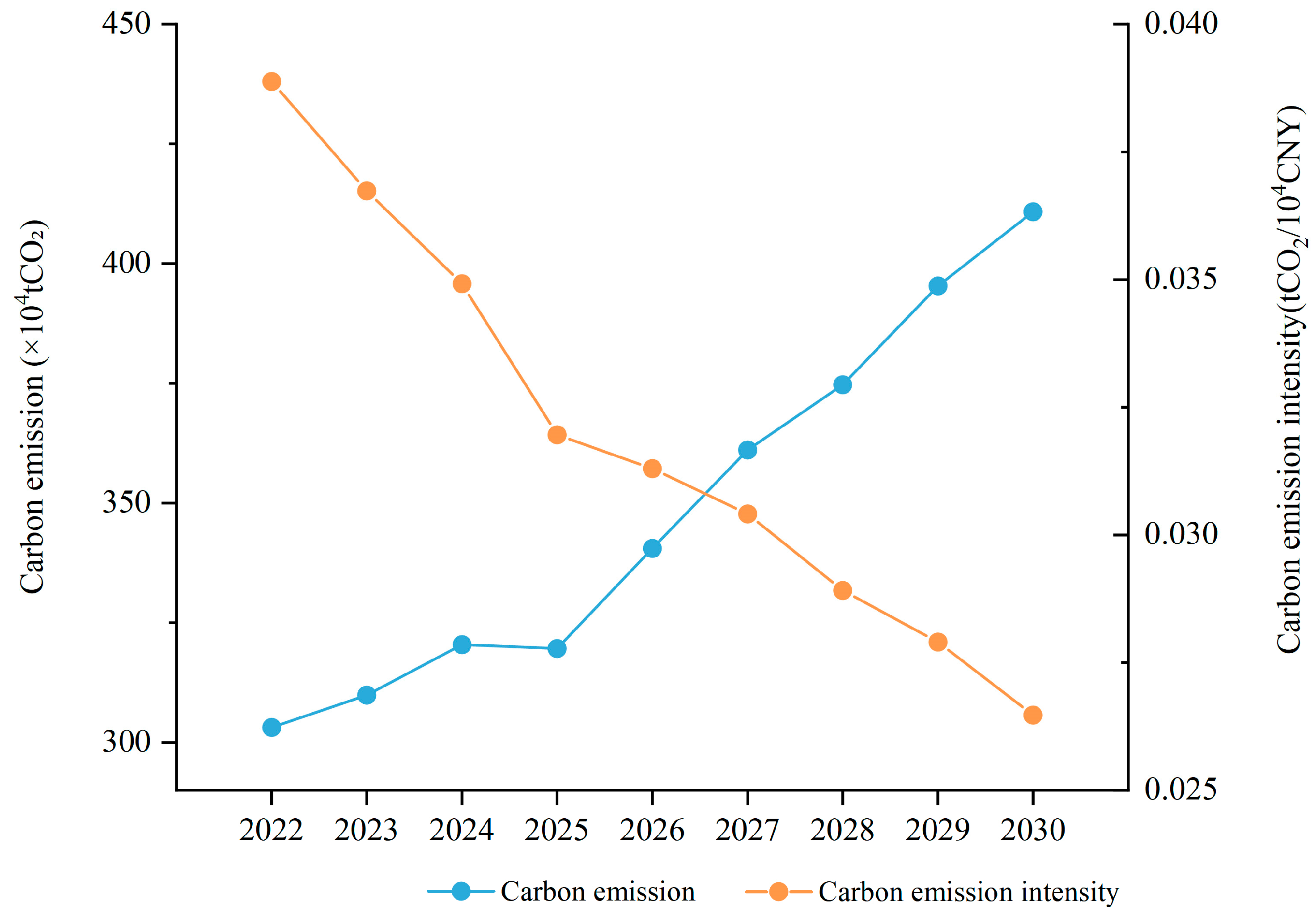
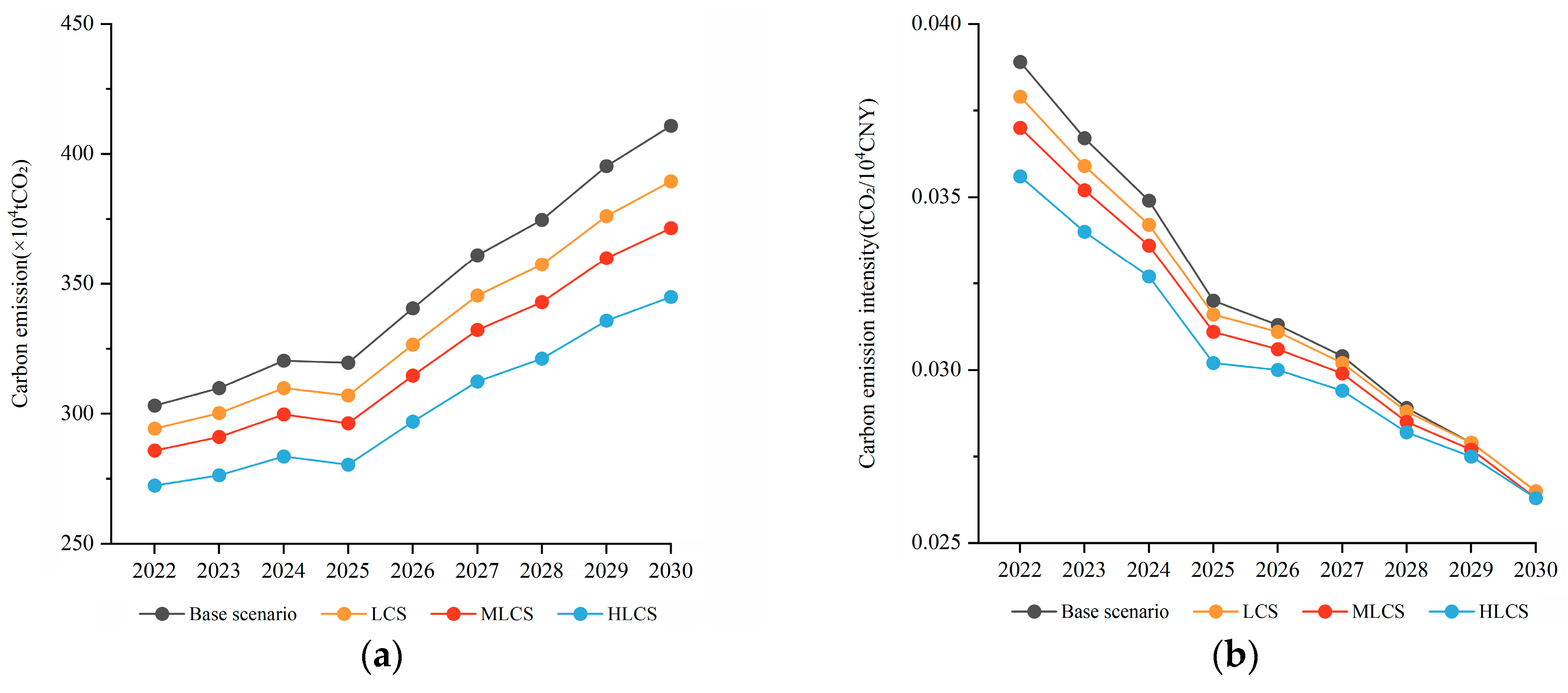
| Energy Source | Average Status Heat Generation | Conversion Factor of Standard Coal |
|---|---|---|
| Raw coal | 20,934 kJ/kg (5000 kcal/kg) | 0.7143 kgce/kg |
| Petroleum | 38,979 kJ/kg (9310 kcal/kg) | 1.3300 kgce/m3 |
| Liquefied petroleum gas | 50,242 kJ/kg (12,000 kcal/kg) | 1.7143 kgce/kg |
| Coke oven gas | 18,003 kJ/kg (4300 kcal/kg) | 0.6143 kgce/m3 |
| Year | Total Carbon Emissions (×104 tons) | Total Energy Consumption of Urban Dwellings (×104 kg of Standard Coal) | ||||
| Actual Value | Analog Value | Error (%) | Actual Value | Analog Value | Error (%) | |
| 2014 | 183.90 | 175.79 | −4.41 | 63,860.22 | 61,367.40 | −3.90 |
| 2015 | 204.53 | 200.36 | −2.04 | 66,060.51 | 64,953.10 | −1.68 |
| 2016 | 229.72 | 235.12 | 2.35 | 73,715.49 | 75,579.30 | 2.53 |
| 2017 | 216.53 | 228.81 | 5.67 | 68,773.18 | 72,669.80 | 5.67 |
| 2018 | 193.77 | 200.75 | 3.60 | 59,051.58 | 61,263.10 | 3.75 |
| 2019 | 243.11 | 252.94 | 4.04 | 75,167.47 | 78,455.60 | 4.37 |
| 2020 | 246.66 | 263.90 | 6.99 | 73,286.46 | 78,509.00 | 7.13 |
| 2021 | 310.24 | 298.87 | −3.67 | 94,492.23 | 91,599.80 | −3.06 |
| Year | Per capita Disposable Income of Urban Residents (CNY) | Energy Consumption Expenditure of Urban Residents (CNY) | ||||
| Actual Value | Analog Value | Error (%) | Actual Value | Analog Value | Error (%) | |
| 2014 | 31,295 | 32,603.8 | 4.18 | 625.27 | 657.28 | 5.12 |
| 2015 | 33,955 | 34,176.5 | 0.65 | 642.27 | 646.88 | 0.72 |
| 2016 | 36,739 | 36,458.7 | −0.76 | 728.59 | 705.00 | −3.24 |
| 2017 | 39,788 | 40,350.6 | 1.41 | 696.61 | 737.61 | 5.89 |
| 2018 | 42,988 | 42,506.7 | −1.12 | 596.19 | 585.44 | −1.80 |
| 2019 | 46,289 | 50,356.6 | 8.79 | 779.43 | 764.77 | −1.88 |
| 2020 | 48,018 | 46,268.5 | −3.64 | 551.03 | 553.71 | 0.49 |
| 2021 | 52,523 | 48,916.6 | −6.87 | 763.00 | 718.87 | −5.78 |
| Programmatic | Adjustment Range |
|---|---|
| Basic program | Keeping the system’s factors constant and progressing smoothly at the pace prior to the x-factor |
| Option 1 | Constant factors in the system, reduce factor x by 1 percentage point |
| Option 2 | Constant factors in the system, increase factor x by 1 percentage point |
| Option 3 | Constant factors in the system, increase factor x by 2 percentage points |
| Year of Modeling | Basic Program | Accelerating the Urbanization Process | Accelerating Economic Development | Increased Residential Investment | Increasing the Level of Residential Energy Consumption |
|---|---|---|---|---|---|
| 2022 | 303.12 | 311.00 | 304.10 | 303.43 | 304.30 |
| 2023 | 309.88 | 317.82 | 311.97 | 310.19 | 311.08 |
| 2024 | 320.42 | 328.47 | 323.78 | 320.74 | 321.62 |
| 2025 | 319.62 | 327.49 | 324.25 | 319.92 | 320.82 |
| 2026 | 340.54 | 348.62 | 346.71 | 340.84 | 341.74 |
| 2027 | 361.06 | 369.40 | 369.06 | 361.36 | 362.27 |
| 2028 | 374.69 | 383.17 | 384.72 | 374.99 | 375.91 |
| 2029 | 395.35 | 404.10 | 407.78 | 395.65 | 396.59 |
| 2030 | 410.82 | 419.76 | 426.02 | 411.12 | 412.08 |
| Year of Modeling | Basic Program | Raising Low-Carbon Awareness | Increased Investment in Research | Optimizing the Energy Mix | Expansion of Green Areas |
|---|---|---|---|---|---|
| 2022 | 303.12 | 302.13 | 302.20 | 301.72 | 302.72 |
| 2023 | 309.88 | 308.78 | 308.86 | 308.45 | 309.48 |
| 2024 | 320.42 | 319.18 | 319.28 | 318.93 | 320.01 |
| 2025 | 319.62 | 318.26 | 318.39 | 318.10 | 319.20 |
| 2026 | 340.54 | 338.97 | 339.13 | 338.90 | 340.12 |
| 2027 | 361.06 | 359.24 | 359.44 | 359.31 | 360.64 |
| 2028 | 374.69 | 372.63 | 372.87 | 372.85 | 374.26 |
| 2029 | 395.35 | 392.97 | 393.28 | 393.41 | 394.92 |
| 2030 | 410.82 | 408.10 | 408.49 | 408.79 | 410.38 |
| Norm | Base Case | Low-Carbon Scenario (LCS) | Medium Low-Carbon Scenario (MLCS) | High Low-Carbon Scenario (HLCS) |
|---|---|---|---|---|
| GDP growth rate | Leave the original data unchanged | Reduction of 0.5 percent per year | 1% reduction per year | 2% reduction per year |
| Urbanization rate | Leave the original data unchanged | Reduction of 0.5 percent per year | 1% reduction per year | 2% reduction per year |
| Energy price | Leave the original data unchanged | 1% increase per year | 2% increase per year | 3% increase per year |
| Energy consumption structure | Leave the original data unchanged | 1.5% increase for natural gas, no change for gas, 1% decrease for LPG, 0.5% decrease for electricity | 2% increase for natural gas, no change for gas, 1% decrease for LPG, 1% decrease for electricity | 3% increase for natural gas, no change for gas, 1% decrease for LPG, 2% decrease for electricity |
| Investment in education | Leave the original data unchanged | 1% increase per year | 2% increase per year | 3% increase per year |
| Investment in scientific research | Leave the original data unchanged | 1% increase per year | 2% increase per year | 3% increase per year |
Disclaimer/Publisher’s Note: The statements, opinions and data contained in all publications are solely those of the individual author(s) and contributor(s) and not of MDPI and/or the editor(s). MDPI and/or the editor(s) disclaim responsibility for any injury to people or property resulting from any ideas, methods, instructions or products referred to in the content. |
© 2024 by the authors. Licensee MDPI, Basel, Switzerland. This article is an open access article distributed under the terms and conditions of the Creative Commons Attribution (CC BY) license (https://creativecommons.org/licenses/by/4.0/).
Share and Cite
Xu, J.; Qian, Y.; He, B.; Xiang, H.; Ling, R.; Xu, G. Strategies for Mitigating Urban Residential Carbon Emissions: A System Dynamics Analysis of Kunming, China. Buildings 2024, 14, 982. https://doi.org/10.3390/buildings14040982
Xu J, Qian Y, He B, Xiang H, Ling R, Xu G. Strategies for Mitigating Urban Residential Carbon Emissions: A System Dynamics Analysis of Kunming, China. Buildings. 2024; 14(4):982. https://doi.org/10.3390/buildings14040982
Chicago/Turabian StyleXu, Jian, Yujia Qian, Bingyue He, Huixuan Xiang, Ran Ling, and Genyu Xu. 2024. "Strategies for Mitigating Urban Residential Carbon Emissions: A System Dynamics Analysis of Kunming, China" Buildings 14, no. 4: 982. https://doi.org/10.3390/buildings14040982





